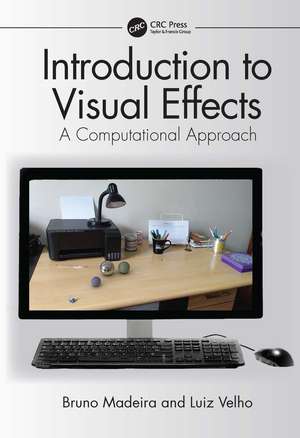Introduction to Visual Effects: A Computational Approach
Autor Bruno Madeira, Luiz Velhoen Limba Engleză Paperback – 8 oct 2024
Key features include:
- Introduction to projective geometry, image-based lighting (IBL), global illumination solved by the Monte Carlo method (Pathtracing), an explanation of a set of optimization methods, and the techniques used for calibrating one, two, and many cameras, including how to use the RANSAC algorithm in order to make the process robust, and providing code to be implemented using the Gnu Scientific Library.
- C/C++ code using the OpenCV library, to be used in the process of tracking points on a movie (an important step for the matchmove process), and in the construction of modeling tools for visual effects.
- A simple model of the Bidirectional Reflectance Distribution Function (BRDF) of surfaces and the differential rendering method, allowing the reader to generate consistent shadows, supported by a code that can be used in combination with a software like Luminance HDR.
| Toate formatele și edițiile | Preț | Express |
|---|---|---|
| Paperback (1) | 259.67 lei 43-57 zile | |
| CRC Press – 8 oct 2024 | 259.67 lei 43-57 zile | |
| Hardback (1) | 401.06 lei 43-57 zile | |
| CRC Press – 6 dec 2022 | 401.06 lei 43-57 zile |
Preț: 259.67 lei
Preț vechi: 373.56 lei
-30% Nou
Puncte Express: 390
Preț estimativ în valută:
49.69€ • 52.02$ • 41.11£
49.69€ • 52.02$ • 41.11£
Carte tipărită la comandă
Livrare economică 07-21 aprilie
Preluare comenzi: 021 569.72.76
Specificații
ISBN-13: 9781032061245
ISBN-10: 1032061243
Pagini: 242
Ilustrații: 84
Dimensiuni: 178 x 254 mm
Greutate: 0.44 kg
Ediția:1
Editura: CRC Press
Colecția CRC Press
Locul publicării:Boca Raton, United States
ISBN-10: 1032061243
Pagini: 242
Ilustrații: 84
Dimensiuni: 178 x 254 mm
Greutate: 0.44 kg
Ediția:1
Editura: CRC Press
Colecția CRC Press
Locul publicării:Boca Raton, United States
Public țintă
Postgraduate, Professional, Professional Practice & Development, and Undergraduate AdvancedCuprins
1. Introduction. 2. Virtual Camera. 3. Optimization Tools. 4. Estimating one camera. 5. Estimating two cameras. 6. Feature Tracking. 7. Estimating many cameras. 8. Modeling Tool. 9. Light Transport and Monte Carlo. 10. Image Based Lighting.
Recenzii
"The Introduction to Visual Effects: A Computational Approach offers a clear, engaging and well-researched account of fundamental principles that have been used to give life to incredible storytelling for many generations. It is the best reference I have found for academics, studios and enthusiasts alike."
- Matteo Moriconi, Director of VFXRio.
- Matteo Moriconi, Director of VFXRio.
Notă biografică
Bruno Madeira is a computer engineer from the Military Institute of Engineering (IME). He received his master's and DSc degrees in mathematics with emphasis on computer graphics and vision at IMPA. He has more than 15 years of experience teaching computer graphics at IME and is a member of the Simulators Group at CTEx, Brazil.
Luiz Velho is a senior researcher, professor, and a VISGRAF Laboratory leading scientist at the National Institute for Pure and Applied Mathematics (IMPA), Brazil. His academic background includes a BE in industrial design from ESDI-UERJ, an MS in computer graphics from MIT Media Lab, and a PhD in computer science from the University of Toronto. His experience in computational media spans the fields of modeling, rendering, imaging, and animation.
Luiz Velho is a senior researcher, professor, and a VISGRAF Laboratory leading scientist at the National Institute for Pure and Applied Mathematics (IMPA), Brazil. His academic background includes a BE in industrial design from ESDI-UERJ, an MS in computer graphics from MIT Media Lab, and a PhD in computer science from the University of Toronto. His experience in computational media spans the fields of modeling, rendering, imaging, and animation.
Descriere
Introduction to Visual Effects is the first single introduction to the computational and mathematical aspects of Visual Effects, incorporating both computer vision and graphics. It provides the reader with the source code to a library, enabling them to follow the chapters directly and build up a complete Visual Effects platform.
